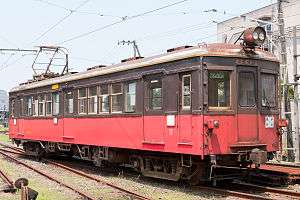Choshi Electric Railway 800 series
The Choshi Electric Railway 800 series (銚子電鉄800形, Chōshi Dentetsu 800-gata) was an electric multiple unit (EMU) train type operated by the private railway operator Choshi Electric Railway in Chiba Prefecture, Japan, between 1986 and September 2010.[1]
| Choshi Electric Railway 800 series | |
|---|---|
 DeHa 801 at Nakanocho Depot in July 2010 | |
| In service | 1986– September 2010 |
| Manufacturer | Teikoku Sharyo |
| Constructed | 1950 |
| Refurbished | February 1986 |
| Number built | 1 vehicle |
| Number in service | None |
| Formation | Single car |
| Fleet numbers | DeHa 801 |
| Capacity | 120 (40 seated) |
| Operator(s) | Choshi Electric Railway |
| Depot(s) | Nakanochō |
| Specifications | |
| Car body construction | Steel |
| Car length | 16,210 mm (53 ft 2 in) |
| Width | 2,700 mm (8 ft 10 in) |
| Height | 4,033 mm (13 ft 2.8 in) |
| Doors | 3 per side |
| Weight | 28.2 t |
| Traction system | MB-64-C (48.49 kW x4) |
| Power output | 194 kW |
| Electric system(s) | 600 V DC overhead wire |
| Current collection method | PS13 pantograph (x1) |
| Bogies | Nippon Sharyo D-16 |
| Track gauge | 1,067 mm (3 ft 6 in) |
Build details
| No. | Former No. | Manufacturer | Build date | Conversion date | Withdrawal date |
|---|---|---|---|---|---|
| DeHa 801 | MoHa 106 | Teikoku Sharyo | 1950 | 12 February 1986 | September 2010 |
Interior
The train had longitudinal seating and was equipped with fare collection boxes at each end for wanman driver only operation. It was not equipped with air-conditioning.
- Interior view of DeHa 801, November 2009
History
One single car was converted in February 1986 from former Iyo Railway 100 series car MoHa 106, purchased in October 1985. This car was built in 1950 by Teikoku Sharyo as KuHa 405, and converted to become single-car MoHa 106 with an additional driving cab in 1961.[3] The second driving cab was subsequently taken out of use and a gangway door added, but from 1967, the driving cab was reinstated, with the gangway door left in place.[3]
Conversion for use on the Choshi Electric Railway involved sealing the gangway in the later added cab end (at the Tokawa end), and replacement of the original Hitachi MIC bogies with Nippon Sharyo D-16 type bogies.[1]
 Iyo Railway MoHa 103 (car of the same type) shortly before withdrawal in 1984
Iyo Railway MoHa 103 (car of the same type) shortly before withdrawal in 1984 Nippon Sharyo D-16 bogie, July 2010
Nippon Sharyo D-16 bogie, July 2010
The car was repainted in 1990 from the earlier red and cream livery to the "new" Choshi Electric Railway livery of brown and red.[1]
It was withdrawn after its final day of operation on 23 September 2010.[4] It was initially stored in the loop next to Tokawa Station before being moved to storage behind Kasagami-Kurohae Station.[5] From 1 May 2015, stored next to Tokawa Station, the car was used to house the Keiyo Towa Pharmaceutical Shōwa Nostalgia Museum, containing exhibits of toys from the Shōwa period (1925–1989).[6]
 DeHa 801 viewed from the up (Choshi) end in July 2010
DeHa 801 viewed from the up (Choshi) end in July 2010- Withdrawn DeHa 801 stored next to Tokawa Station in January 2012
- Withdrawn DeHa 801 as the Keiyo Towa Pharmaceutical Shōwa Nostalgia Museum at Tokawa Station in October 2015
References
- Satō, Toshio (December 2009). 銚子電鉄の電車たちを訪ねて [Visiting the trains of the Chōshi Electric Railway]. Japan Railfan Magazine (in Japanese). Vol. 49 no. 584. Japan: Koyusha Co., Ltd. pp. 92–96.
- "昭和年度下半期(60.10.1~61.3.31)私鉄車両のうごき" [Private railway rolling stock changes (1 Oct 1985 – 31 Mar 1986)]. Railway Journal (237): 141. September 1986.
- Shirato, Sadao (July 2011). 銚子電気鉄道(下) [Choshi Electric Railway Volume Two]. Japan: Neko Publishing Co., Ltd. pp. 38–40. ISBN 978-4-7770-5310-0.
- 銚子電気鉄道デハ701・デハ801が引退 [Choshi Electric Railway DeHa701 & DeHa 801 Withdrawn]. RM News (in Japanese). Japan: Neko Publishing. 24 September 2010. Retrieved 25 September 2010.
- Terada, Hirokazu (September 2013). 日本のローカル私鉄 30年前の残照を訪ねて その7 [Japan's rural private railways: Revisiting the afterglow of 30 years ago (Part 7)]. Japan Railfan Magazine (in Japanese). Vol. 53 no. 629. Japan: Koyusha Co., Ltd. pp. 98–103.
- 銚子電気鉄道 駅名(愛称)ネーミングライツ募集 [Choshi Electric Railway offers station naming rights]. Tetsudo Hobidas (in Japanese). Japan: Neko Publishing. 1 May 2015. Retrieved 2 May 2015.
External links
| Wikimedia Commons has media related to Choshi Dentetsu 800 series. |
- Choshi Electric Railway rolling stock profiles (in Japanese)
